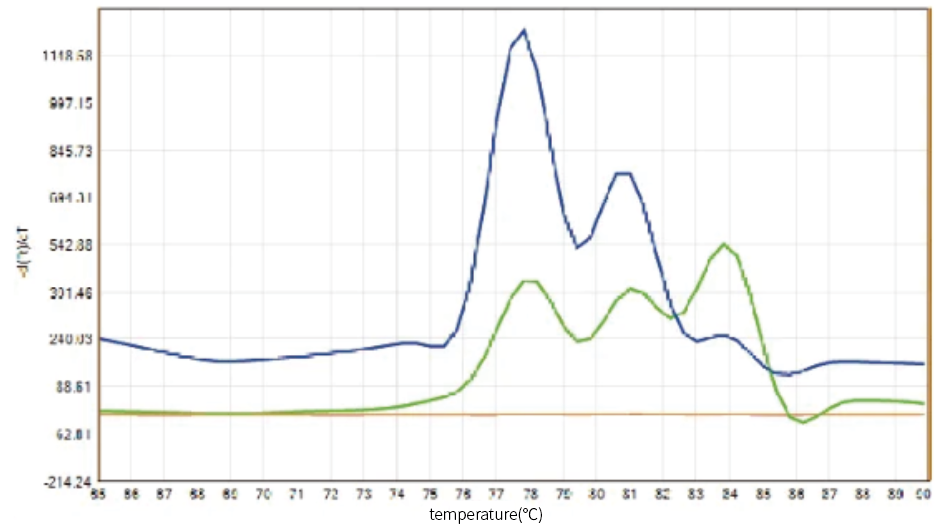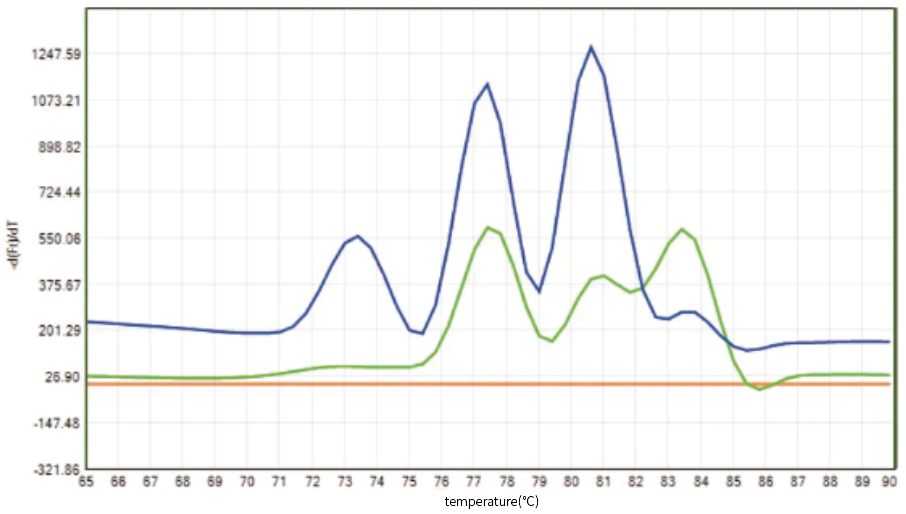The detection of multiple targets is one of the significant applications in the field of molecular diagnostic technology. TaqMan probe real-time fluorescence quantitative polymerase chain reaction is the mainstay in PCR technology, yet it operates on a singular dimension—fluorescence—restricting each channel to detect only one target, tying efficiency to the number of channels. Since channels can't be added indefinitely due to fluorescence interference, this caps the technology's sensitivity, specificity, and ability to handle complex diseases.
The multicolor melting curve analysis method adds a twist by using temperature as an additional dimension. This approach, which measures the DNA melting temperature (Tm), allows for plotting temperature against fluorescence changes. By doing so, one channel can identify 6-8 targets, significantly boosting efficiency. This approach also offers advantages such as high throughput, simplicity in operation, low cost, and reliable accuracy.Despite its theoretical efficiency, melting curve analysis’ wide adoption is challenged by unsatisfactory sensitivity and specificity performance, as well as difficulties in curve interpretation currently.
To address these challenges, BiOligo has innovated underlying technological methods and developed Specialty Prime products, comprising three sets of melting curve solutions involving modified raw materials, enzymes, and fluorescent labels.
Challenges of the melting curve analysis method
1. The fluorescence intensity of FRET probe highly depends on the distance and spectral overlap between the fluorophore and quencher group. The probe sequence length is limited (≤30 nt), making it challenging to adjust the Tm value.
2. Asymmetric amplification, while commonly adopted, suffers from low yield and sensitivity due to linear DNA amplification.
3. Symmetric amplification offers a potential solution with its exponential DNA amplification, promising higher yield and sensitivity. However, it faces significant technical hurdles, notably with fluorescent probes not binding in double-stranded DNA product, complicating the fluorescence-Tm correlation.
Solution for Melting Curve Fluorescent Probes
To address the complexity of designing multicolor melting curve probes and issues such as undulant baselines, upside-down peaks, and low sensitivity, Bioligo has developed the RQP series fluorescent probes based on asymmetric melting curves and the RQ series fluorescent probes based on symmetric melting curves. These probes can be used in commonly channels of qPCR instruments and be suitable for single-tube multi-target detection, including multiplex pathogen DNA detection and multiple targets detection.
Asymmetric Melting Curve Fluorescent Probe Solution (RQP Series)
Product Information:
The RQP series fluorescent probes consist of a 5' fluorescent modification and a 3' RQP. The following combinations are available for the commonly used four fluorescence channels:
channel | modification | |
5' | 3' | |
FAN | BF490 | RQP |
VIC | BF533 | |
ROX | BF590 | |
Cy5 | BF648 | |
Product Features:
1. Flexible Probe Design
Compared with FRET probes, the RQP series probes overcome limitations of limited probe length and high GC content. There are no restrictions on probe length, eliminating the need for molecular beacon design. This flexibility allows for easier Tm adjustment and simpler probe design.
2. Melting Curve Detection Results
(1) High Melting Curve Peaks Emergence:
This method overcomes issues related to difficult interpretations, high error rates.
(2) Non-specific peaks disappeared
The RQP series probes have no fluorescence signal in case of base mismatches, thus avoiding non-specific melting curve peaks effectively .
(3) Stable baselines, clear peaks, and more accurate interpretation
The fluorescence of RQP series probes do not change during amplification or melting curve analysis. The upside-down peaks are avoided, producing curves with stable baselines, clear peaks, making them easy to interpret and significantly improving reading efficiency.
The following figure shows a comparison between the melting curve analysis of RQP probes and FRET probes. It's clearthat the baseline of RQP probes is significantly stable.
 |  |
| RQP Probes | FRET Probes |
Symmetric Melting Curve Fluorescent Probes (RQ Series)
Product Information:
The RQ series fluorescent probes consist of a 5' fluorescent modification and a 3' RQ. The following combinations are available for the commonly used four fluorescence channels:
channel | modification | |
5' | 3' | |
FAN | BF490 | RQ |
VIC | BF533 | |
ROX | BF590 | |
Cy5 | BF648 | |
Product Features:
1. Bioligo owns proprietary technology and globally patented, not conflicted by any other patents on symmetric melting curve methods.
2. Bioligo overcomes technical challenges of fluorescence-Tm correlation by its globally patented self-quenching fluorescence-modified probes (RQ probes), which can eliminate the need for separate quenchers. This breakthrough simplifies the construction of detection curves.
(1) High sensitivity, better universality, and reduced risk of false negatives
The RQ modification has no effect on PCR amplification. The sensitivity is comparable to Taqman probe method and far exceeds asymmetric melting curve analysis. The detection limit for each target can reach 20 copies per reaction.
 |  |  |
All six targets are at 500 copies per reaction | All six targets are at 50 copies per reaction | All six targets are at 20 copies per reaction |
As shown in the above figure, the blue curve represents the BF490-modified probes, with the targets from left to right being HPV types 56, 59, and 68;The green curve represents the BF533-modified probes, with the targets from left to right being HPV types 35, 73, and 51. | ||
(2) High Melting Curve Peaks Emergence, clear peaks, distinct separation of multiple targets in a single channel
The RQ probes exhibit significant fluorescence changes across multiple channels, enabling clear differentiation of multiple targets in a single channel.
 |  |
The figure shows gastrointestinal pathogen detection. The blue curve represents BF490/RQ-modified primers, with the targets from left to right being CamJ, SalS, VibCO139, VibCO1, and Brucella. The green curve represents BF533/RQ-modified primers, with the targets from left to right being CloD, StaA, O157:H7, VibP, and ShiS. The concentration of each target is 500 copies per reaction. | The figure shows the detection of different HPV genotypes. The blue curve represents BF490/RQ-modified probes, with the targets from left to right being HPV31, HPV59, HPV18, and HPV68. The green curve represents BF533/RQ-modified probes, with the targets from left to right being HPV35, HPV16, and HPV51. The concentration of each target is 500 copies per reaction. |
(3) Stable baselines, clear peaks, and more accurate interpretation.




